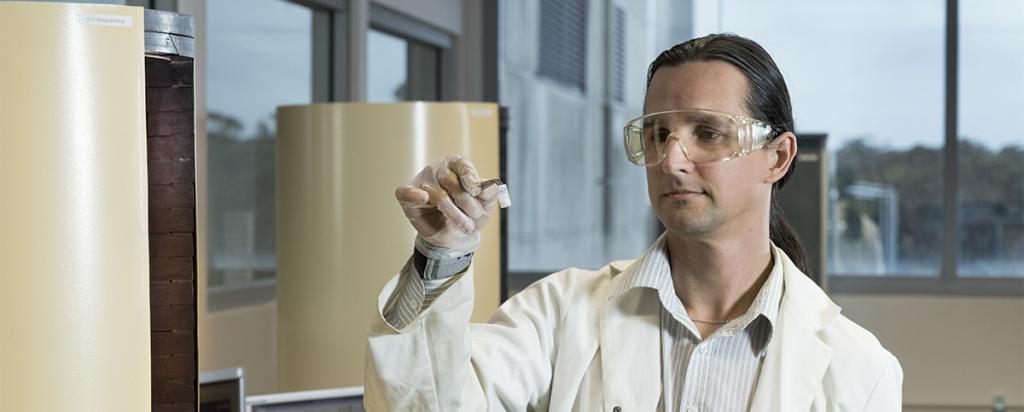
Neutron Activation Analysis and Neutron Irradiation
Neutron activation analysis
Neutron activation analysis (NAA) is a very sensitive method of quantitative multi-elemental analysis. It has the potential to determine concentrations in a sample from ppb to tens of percent, depending on the particular element and bulk matrix composition.
Samples are irradiated in the OPAL research reactor. After irradiation the specific activity of each radionuclide in the sample may be determined by measuring the energy and intensity of characteristic gamma rays that are emitted.
Radionuclides that have a short half-life (minutes to hours) are best measured after a short irradiation and those with a long half-life (days to years) are irradiated for a longer time.
To offer the greatest flexibility to clients and collaborators, both the relative method of standardisation and the k0-method of standardisation have been implemented.
The neutron spectrum at the NAA irradiation positions in the OPAL reactor is very highly thermalised, with a thermal to epithermal ratio (f) of greater than 1,500. Many of the interfering reactions produced in other research reactors are avoided in the OPAL facility.
Strengths of neutron activation analysis
- Minimal sample preparation for solid forms and powders.
- Large dynamic range of concentrations, from ppm or even ppb to tens of percent.
- Large dynamic range of sample weights, from a few mg up to several g.
- Good accuracy with typical uncertainties around 4 to 5% and good precision.
- The multi-element capability provided by the k0-method means that up to 65 elements can be quantified with just two irradiations.
- Fully traceable to primary SI-standards. The relative method is recognised as a primary ratio method.
- Quality in our laboratory is assured through the use of certified reference materials and participation in international intercomparisons at the highest metrological level, such as CCQM key comparisons.
Elements quantified by neutron activation analysis
Neutron activation analysis (NAA) is used to determine concentrations in a sample. It offers a highly reliable measurement technique fully traceable to primary SI-standards.
Short Irradiation
A short irradiation of up to 15 minutes may allow the concentration of the following elements to be determined:
Al, Ca, Cl, Cu, Dy, I, In, Mg, Mn, Na, Rh, S, Ti, V.
Long Irradiation
A long irradiation of up to 20 hours may enable the analysis of:
Ag, As, Au, Ba, Br, Ca, Ce, Cd, Co, Cr, Cs, Er, Eu, Fe, Ga, Ge, Gd, Hf, Hg, Ho, In, Ir, K, La, Lu, Mo, Nb, Nd, Os, Pd, Pr, Pt, Rb, Re, Ru, Sb, Sc, Se, Sm, Sn, Sr, Ta, Tb, Te, Th,Tm, U, W, Yb, Zn, Zr.
Reporting times will depend on reactor scheduling but typically reports may be issued within a month of receipt of samples for short irradiations and within two months where long irradiations are required.
Neutron Irradiations
There is a wide range of potential applications for neutron irradiations. They vary from irradiating minerals for geochronology studies, subjecting materials to neutron damage for material research, to irradiating tracer substances for various research, environmental, and industrial processes and applications. A total of 57 irradiation facilities are available at seven levels of thermal neutron flux to perform a wide range of irradiations.
Facilities are available for canning of samples for irradiation, post irradiation handling and quick return of the irradiated sample in a suitable shielded container if required. Technical advice on the usage and methods to minimise radiation levels are also available.
The availability of this service is dependent on reactor scheduling. Please contact ANSTO prior to ensure correct scheduling is achieved.
Capability selection
- OPAL low flux (thermal = 2-8 × 1012 cm-2s-1)
- OPAL medium flux (thermal = 1-4 × 1013 cm-2s-1)
- OPAL high flux (thermal = 0.6-1 × 1014 cm-2s-1, fast = 3.5 × 1012 cm-2s-1 in LE7)
- OPAL fast flux (thermal = 1.1 × 1014 cm-2s-1, fast = 1.2 × 1013 cm-2s-1)
- OPAL short residence D (thermal = 5.0 × 1012 cm-2s-1)
- OPAL short residence N (thermal = 2.2 × 1013 cm-2s-1)
Attila Stopic
Neutron Activation Scientist
